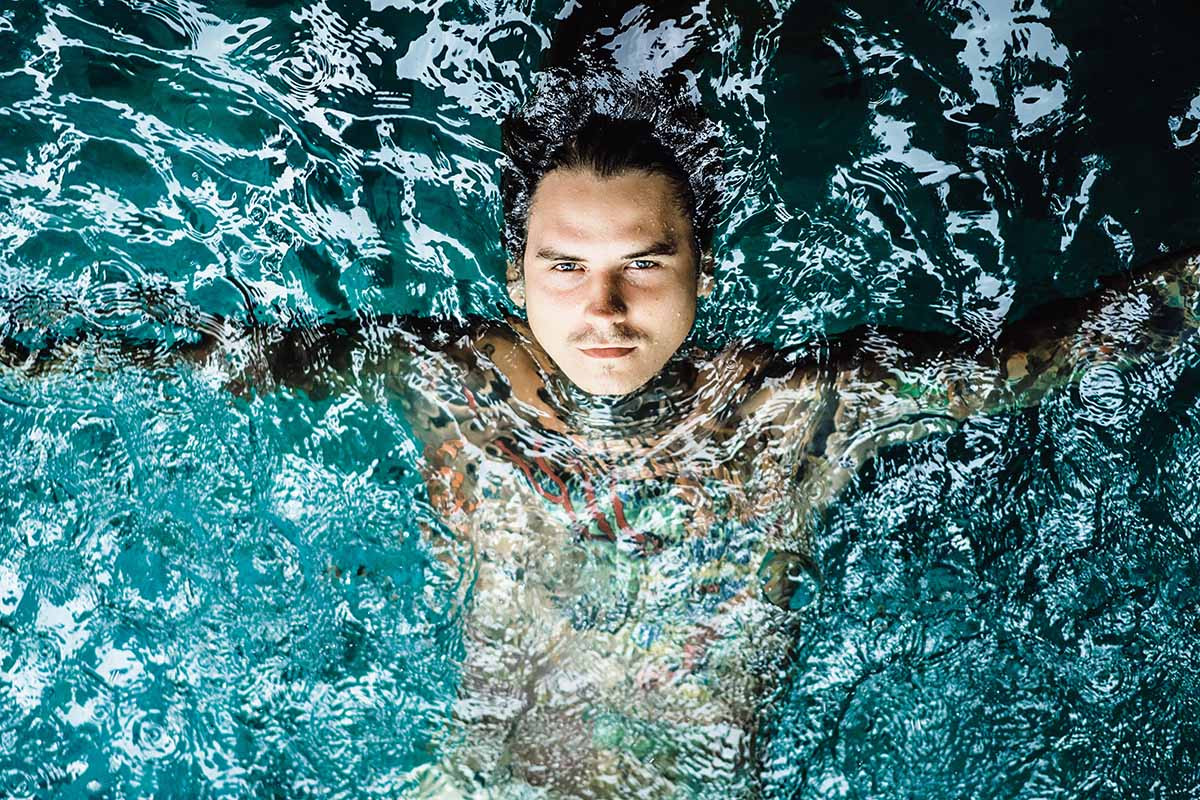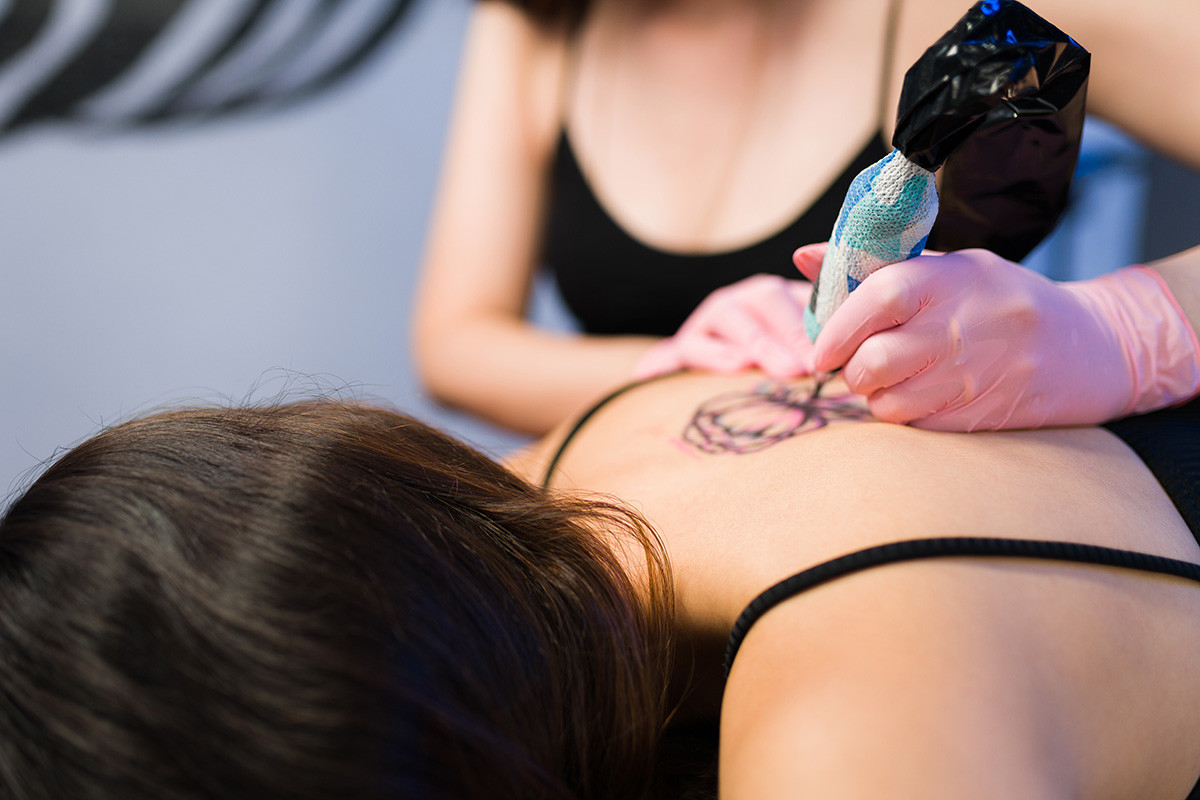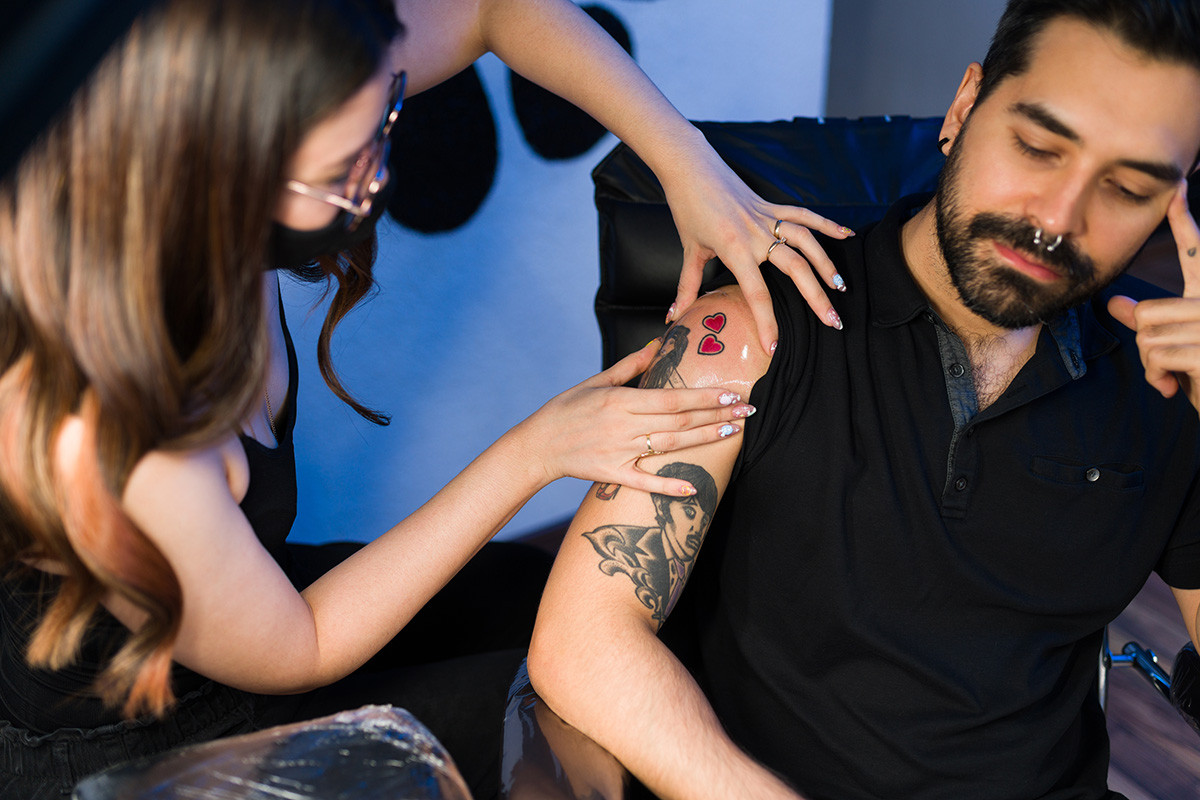Can I Go Swimming With A Fresh Tattoo? Yes, waiting is key. Submerging your new tattoo in water too soon can lead to infections and damage. Tattooat.com is here to guide you through the healing process, offering tips and advice to protect your body art. Discover how to ensure your tattoo heals beautifully with our expert advice on aftercare and safe water activities for tattooed skin, ensuring vibrant tattoo preservation.
Table of Contents
1. When Can You Dive In? Understanding Tattoo Healing
Getting a new tattoo is exciting. However, proper aftercare is essential for your skin and tattoo design. Tattoo artists often advise waiting 2-4 weeks before exposing your fresh ink to water, be it pools, oceans, or hot tubs. This waiting period helps avoid complications.
 A person getting a new tattoo and the healing process
A person getting a new tattoo and the healing process
-
The Stages of Tattoo Healing
The tattoo healing process involves several stages. Initially, expect swelling, pain, and some oozing. This is followed by itching and peeling. Complete healing can take 2 to 4 weeks, or even up to 6 months for some. Avoid swimming during this phase to prevent irritation and ensure proper healing.
-
Factors Affecting Healing Time
Several factors influence tattoo healing:
- Tattoo Size: Larger tattoos take longer to heal.
- Tattoo Location: Areas with more friction may heal slower.
- Aftercare: Proper cleaning and moisturizing are crucial.
- Skin Type: Individual skin types affect healing speed.
Closely monitor your tattoo and consult your artist if you have any concerns.
2. Risks of Swimming with a Fresh Tattoo
Swimming with a new tattoo can lead to several problems. Water exposure can dry out the skin, causing itching, flaking, and scabbing. This can also result in fading and blurred lines, ruining your fresh tattoo.
-
Bacterial Infections and Open Wounds
Tattoos are essentially open wounds. Swimming exposes them to bacteria in pools, lakes, and oceans. This can cause infections and prolong the healing process. Keeping your tattoo clean and protected is crucial to avoid such issues.
According to a study by the American Academy of Dermatology, approximately 1-5% of individuals with new tattoos experience some form of infection. This highlights the importance of proper aftercare and avoiding potential sources of bacteria.
-
Chlorine and Salt Water Effects
Chlorine and salt water can harm fresh tattoos by causing:
- Irritation
- Fading
- Discoloration
- Ink Leaching
Chlorine doesn’t kill all bacteria and can dry out the skin, hindering healing.
3. Protecting Your New Tattoo While Swimming
If swimming is unavoidable, take precautions to protect your tattoo. Use waterproof dressings and bandages to shield it from water and bacteria. However, this is not ideal and doesn’t guarantee complete protection.
 A person protecting their new tattoo while swimming with waterproof dressings and bandages
A person protecting their new tattoo while swimming with waterproof dressings and bandages
-
Waterproof Dressings and Bandages
Waterproof dressings can protect new tattoos. Popular options include:
- Saniderm Tattoo Aftercare Bandage
- Recovery Derm Shield Tattoo Aftercare Bandage
- Tattoo Aftercare Waterproof Bandage
- Nexcare Tattoo Bandages
- Nuanchu Waterproof Bandage
Apply before swimming and change regularly.
-
Post-Swim Care
After swimming, clean your tattoo with warm water and mild soap. Pat it dry and apply a thin layer of fragrance-free moisturizer. This post-swim care is vital for maintaining your tattoo’s health and appearance.
4. Signs Your Tattoo Is Ready for Swimming
Once fully healed, swimming is safe. Signs of a healed tattoo include no redness, itching, scabbing, or flaking, and a smooth, even appearance. Consult your tattoo artist if unsure.
-
Visual Indicators
Look for:
- No bubbling or degradation
- No redness or peeling
- Smooth, even appearance
Monitor your tattoo closely.
-
Consulting Your Tattoo Artist
Your tattoo artist can assess your tattoo’s progress and advise on when it’s safe to swim. It’s always better to err on the side of caution.
5. Alternative Water Activities for Tattoo Healing Period
Avoid swimming during healing. Instead, take gentle showers, avoiding direct water jets. Boiling tap water for cleansing can minimize infection risk.
 A person enjoying alternative water activities during the tattoo healing period
A person enjoying alternative water activities during the tattoo healing period
6. Hot Tubs, Saunas, and Other Water Hazards
Hot tubs and saunas increase infection risk and hinder healing. Wait at least 3-4 weeks before using them.
7. Swimming in the Ocean with a New Tattoo: What to Know
Swimming in the ocean with a new tattoo requires extra caution due to the presence of marine bacteria. Here’s what you should consider:
- Risk of Infection: Ocean water contains microorganisms that can cause serious infections in open wounds.
- Salinity: Saltwater can dehydrate the skin and potentially draw out tattoo ink, impacting the tattoo’s vibrancy.
- Debris: The ocean may contain particles that could irritate the healing tattoo.
To mitigate these risks, adhere to strict aftercare guidelines and keep the tattoo covered with waterproof bandages until it is fully healed.
8. Pool Swimming with a New Tattoo: Essential Precautions
When it comes to pool swimming, the chlorine levels and potential for bacterial exposure present particular risks for new tattoos:
- Chlorine Irritation: Chlorine can cause irritation and dryness, impeding the healing process.
- Bacteria Exposure: Pools can harbor bacteria despite chlorination, raising the possibility of infection.
- Chemical Reactions: The interaction between pool chemicals and tattoo ink may lead to fading or discoloration.
To avoid these issues, it’s best to stay out of the pool until the tattoo is fully healed. If you must swim, protect the tattoo with a waterproof bandage and clean it immediately after swimming.
9. Tattoo Aftercare Products: A Detailed Overview
Choosing the right aftercare products is essential for promoting effective tattoo healing. Here are some recommended products:
| Product Type | Brand | Description |
|---|---|---|
| Tattoo Balm | Tattoo Goo | Natural ingredients to soothe and protect the skin. |
| Antibacterial Soap | Dr. Bronner’s | Gentle, fragrance-free soap for cleaning the tattoo. |
| Moisturizing Lotion | Aquaphor Healing | Helps keep the skin hydrated and promotes healing. |
| Sunscreen | EltaMD UV Clear | Broad-spectrum sunscreen to protect the tattoo from sun damage after it’s healed. |
| Waterproof Bandage | Saniderm | Breathable and waterproof bandage to protect the tattoo during the initial healing phase. |
Properly caring for your tattoo involves using these products consistently and following the instructions provided by your tattoo artist.
10. How to Choose a Tattoo Artist and Ensure Safe Tattooing
Selecting a reputable tattoo artist and studio is critical for ensuring a safe and satisfactory tattooing experience:
- Research: Look for artists with positive reviews and a strong portfolio.
- Hygiene Standards: Ensure the studio follows strict hygiene protocols and uses sterilized equipment.
- Consultation: Discuss your design and any concerns you have with the artist before getting tattooed.
- Experience: Choose an artist with extensive experience and a thorough understanding of aftercare practices.
According to Inked Magazine, the best tattoo artists prioritize safety and hygiene and provide detailed aftercare instructions to their clients. This ensures the healing process is as smooth and risk-free as possible.
Summary
Protecting your new tattoo is crucial. Follow aftercare guidelines, use waterproof dressings if necessary, and wait until fully healed before swimming. Patience ensures your tattoo heals beautifully.
Ready to explore stunning tattoo designs and connect with talented artists? Visit Tattooat.com today and dive into the world of body art!
Frequently Asked Questions
What happens if you swim while your tattoo is healing?
Swimming with a new tattoo exposes it to bacteria, causing infections and irritation. Avoid swimming during healing to protect it.
Can I swim 7 days after a tattoo?
No, wait for full healing, at least two to four weeks, before swimming.
How long after a tattoo can you swim in chlorine?
Wait at least two weeks, and ideally four to six weeks, before swimming in chlorine.
Can I use waterproof dressings to protect my tattoo while swimming?
Yes, but ensure it’s fully healed before swimming, even with protection.
What are the risks of swimming with a fresh tattoo?
Risks include bacterial infections, skin irritation, and damage to the design.
Looking for inspiration, expert advice, and a community of tattoo enthusiasts? Head over to tattooat.com now and start your tattoo journey the right way. Let us help you find the perfect design, connect with top artists, and ensure your ink stays vibrant for years to come. Your dream tattoo is just a click away!

